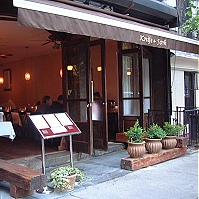Knife & Fork

Photo: Cititour.com
Contact Info:
Address: 108 E 4th St (1st & 2nd Aves)
City: New York, NY
Zip: 10003
map: View the Map
Phone: (212) 228-4885
Website: http://www.knife-fork-nyc.com/
Food Info:
Menu: View the Menu
Cuisine:
New American
Cititour Review:
About a month ago I got an unusual email looking for help. This one was from a novelist named Alison Pace (www.alisonpace.com). And she wasn’t looking for a restaurant suggestion or advice about a career change. She said she was working on a novel about a restaurant critic, and she wondered if she might come to dinner with me to get the inside scoop on the life and times of a real food critic. This sounded fun to me. I assured her that while I was a critic, I was nowhere in the realm of Mimi, Grimes, Ruth, or Bruni, nor Gael, Hal, or Platt. I made sure she knew I was just a writer with a blog and a column in the New York Post. I told her I was often recognized and that I wore no disguises, but I told her I’d probably be able to share a thing or two about the business and would be happy to have her tag along to a dinner one night. That night happened last week, at a little East Village restaurant that has gotten more food buzz than opening day at Shake Shack—a snug 30-seat spot called Knife and Fork. The buzz is not for naught. The restaurant is simply designed in that sort of ubiquitous warm and cozy way, with lots of bare wood accents including a heavy wood-framed mirror over the bar, and exposed brick walls. But here, tables are draped in white linen and the stemware is tall and by Schott Zwiesel. Knife and Fork may look like just your average bistro, but you get the sense that there’s more here than you might think. That something more comes from a small space located off the bar, where chef and owner Damien Brassel cooks and bakes (all of his delicious breads are done in house) in an open kitchen the size of an office cubicle. Brassel is a handsome chap from Ireland who is all of 30 and has been cooking since he was 15. He has a confident hand with seasoning and a steady grasp of classic French technique that he uses to turn out an haute menu of modern European fare. But more than the sophisticated nature of the food on the menu, the restaurant has garnered a reputation for something quite unusual: its value. The chef’s a la carte menu includes appetizers like curried mussels with potato salad and curry oil ($11) and herb-crusted tuna with apple semolina, white asparagus and red pepper reduction ($12) and mains like hake with mussels lemongrass and coconut sauce ($22) and whole quail with chicken and garlic mousse and foie gras mash ($22). But what makes Knife and Fork so unique is the chef’s unheard of 6-course tasting menu (five savory courses, then cheese and dessert) for all of $45. Yes, six courses for forty-five bucks. Needless to say, we opted for that happy meal. Since we were on a reviewing lesson, I started with some basics. A review should always hit several elements of the experience: food, décor, crowd, service, and for me, an overall evaluation of certain intangibles like the energy and the soul of the restaurant. I also mentioned I liked to take note of small details—how clean are the bathrooms, how long it takes for a waiter to approach the table and say hello and offer a cocktail (ditto a bartender). And other little touches like, for instance, bread service. When our bread was served (the man bakes a nice loaf) I pointed it out to Allie. “Bread service is something I always notice,” I said, trying to sound quite like someone who knows what they are talking about. “It shows a great deal about a restaurant and how much attention they pay to detail and to the concept. If I am at high end a French restaurant and I am served a cold hard roll (as I was last week at Perry Street), that says something to me about how much attention the operators are paying.” (For the record, that bread last week at Perry Street could have been used as in batting practice. The restaurant is still gorgeous but the food has lost some of its luster.) I nodded to the bread display at Knife and Fork, which looked like a still life from a Times T Style photo shoot. “This bread plate shows someone in here cares, a lot.” The homemade bread was warm and soft and sliced into thick wedges and fanned out on a rustic farm board topped with a slate saucer that contained a few hand-cut cubes of butter and a mound of flaky sea salt. It showed attention to detail, and it matched the sensibility of the room and the restaurant. That would be check one for Knife and Fork. Brassel starts every table off with an amuse bouche (yes, on East 4th Street). Ours was a hot tomato tea consommé, which possessed the amazingly clean and lively flavors of a ripe summer tomato. It was just the right thing, even on a mercilessly hot summer night, to wake up the palate. Perfect. Check two. Then the real food started to arrive. Courses were nicely paced throughout the evening, and portions were modest in size but nowhere near skimpy. Our first course was a salmon, seared so its skin was crisp as a potato chip and its flesh almost melting. It was set in a smashingly tart and pulpy broth made from cucumber, green apples and passion fruit. It was pure Pow! (In a good way.) Our second course was more advanced in technique and concept, and I didn’t like it as much as the first. It presented a surprisingly mild (read: bland) and meaty filet of mackerel over a salad of shaved fennel that was dressed with tarragon oil that seemed to flatten the fennel’s flavor as well. That fish was redeemed by a startling spoonful of tapioca that was folded in with reduced orange juice, vanilla and a bit of cinnamon. While the mackerel was a shy introvert, that tapioca was brazen and outspoken, and did make up for it. At this point, I pointed out that she needed to remember that the reviewer in her novel should be observing the crowd and the service in the restaurant throughout the meal. First, what sort of crowd is it? Young and hip? Older and more sedate? A mix? Do other tables seem content, or are they craning their necks to get waiter’s attention? Here at Knife and Fork, every table seemed to be enjoying their meal and happily focused on their conversation and food, not on finding a waiter or a busser. The service was attentive and warm. As far as the crowd, there were a few guys in jeans at the bar sharing a few pints and having a chat, and in the dining room nicely spaced tables were filled with casually dressed friends and couples. All in all, people were relaxing over their meal in a room that was actually quiet enough to hold a conversation. After a nice pause, course number three was served. It was my favorite of the evening, a quail breast stuffed with apple and chicken mousse, then poached and roasted—read: tight, crisped skin, meat that tasted confited—and served over a sort of pudding made from foie gras. While the dish tasted a bit too much like fall to me, it was deliciously rich, and the portion was small enough that the excess was just right. Next, Brassel served us a star anise crusted loin of venison over parsnip vanilla puree brightened with some lime. The crust was wonderfully herbaceous against the slightly gamey meat, but the center was a bit too rare and the texture of a rare thick venison chop was not really appealing to me. The lamb came last, and I thought of it as the most divine version of a deconstructed gyro. A gorgeous seared and roasted milk-fed lamb loin is served with a dollop of sheep milk cheese that’s been strained with pureed apricots, giving the cheese a creamy tangy yogurt-like texture and a delicate fruitiness. If I could have gotten my hands on a puffy pita pocket I would have made myself a sandwich. I am fairly certain the chef would not have appreciated that, but it did cross my mind. Since no pita was in site, I just used my knife and fork, and wiped my plate clean. Our cheese course was a nice collection that included a runny, creamy stinky spoonful of Camembert—and our dessert was small but perfect, a pudding like coffee panna cotta that was rich with deep strong espresso tones, and topped with a delicious cinnamon cake beignet and fresh whipped cream. While we ate our dessert, Allie continued her research. Who are her character’s favorite chefs, and what should her character’s favorite restaurants be? How many times should she eat at a restaurant (ideally four to five), what newspaper should she be working for (Times), and if she might have an affair with a chef who should it be (that will not be answered here or anywhere). It was a lot of fun and I am looking forward to reading about her character Meredith in the future. It was late in the evening when the skies opened up and the sky flashed a sort of strobe lightning. The dining room was still home to a few tables, lingering over wine cheese and those donuts. Damien walked over to our table to say hello. (As I said, I am often recognized.) I asked him about the economics of his decision to offer six courses for $45. His reply was something like this: “Well, you know, it’s fine that way. I want people to enjoy their experience and sit for a long time and eat and drink wine and not worry about leaving the table. That’s what it’s about.” When I pressed about whether he thought he could make money serving six courses for a mere $45 without turning the tables, he didn’t seem terribly concerned. “It’s fine. The portions are small and it’s not about that. This is a place where I want people to come in and enjoy themselves.” I couldn’t have said it better myself.
Review By: Andrea Strong
Location:


